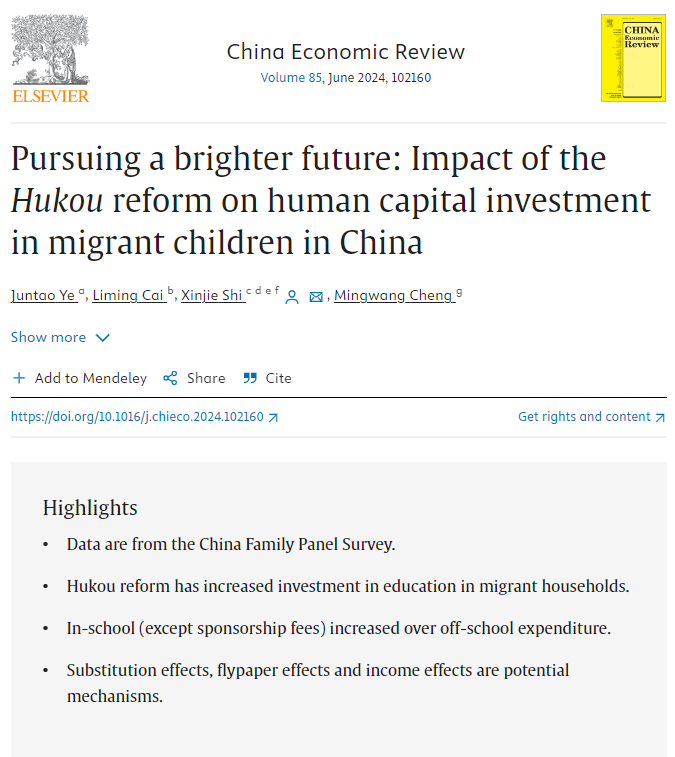近日,浙江大学中国农村发展研究院史新杰研究员(通讯作者)与浙江科技大学叶俊焘教授、同济大学程名望教授以及福建农林大学博士生蔡丽明(原浙江科技大学应用统计专业硕士研究生)合作撰写的学术论文“Pursuing a brighter future: Impact of the Hukou reform on human capital investment in migrant children in China”经济学知名期刊China Economic Review(中国科学院经济学一区,IF=6.8)在线发表。
免费全文下载链接:https://www.sciencedirect.com/science/article/pii/S1043951X2400049X?dgcid=author
英文摘要:
China's Hukou system, established in 1958, institutionalized social welfare disparities. This study examined the impact of China's Hukou reform—an institutional change initiated in 2014 that aimed to gradually expand the coverage of basic social benefits from the local Hukou population to the entire resident population—on the education expenditures of migrant households and the human capital development of migrant children using panel data from the China Family Panel Survey from 2012 to 2018. Drawing on regional variations in the pace of the reform, we applied the difference-in-differences method, and found that the reform significantly increased the investment in education for migrant households, with the increase mainly arising from in-school expenditures (with the exception of sponsorship fees) rather than from off-school expenditures. The analysis of the underlying mechanism shows that, first, although the reform has expanded the access to public education for migrant children, the local governments did not invest more in public education following the reform (substitution effects). Second, the Hukou reform appears to have eliminated resource discrimination and improved quality within the public education system, which increases migrant families' expectations for their children's education; this also prompts them to increase their in-school education expenditures to improve the quality of their children's education (flypaper effects). Finally, increases in migrant family income also play a role (income effects). Our study has strong practical implications for policymakers, who need to sustain the supply of human capital for economic development by providing education to migrant children, while moderating the effects of social welfare reforms to reduce possible governance risks.
文章概要:
起始于1958年的户籍制度造成了社会福利的差异化分配。论文利用2012-2018年中国家庭追踪调查数据(China Family Panel Survey, CFPS),使用双重差分模型(Difference-in-differences, DID)考察了2014年户籍制度改革对农民工家庭教育支出和随迁儿童人力资本发展的影响。研究发现,户籍制度改革显著增加了农民工家庭的教育支出,且主要来自赞助费除外的校内教育支出的增加,而非校外支出。机制分析表明,首先,虽然改革拓展了农民工子女接受公办教育的机会,但地方政府并未因为户籍制度改革而投入更多(替代效应)。其次,户籍改革缓解了公办教育体系内的资源歧视,同时还改善了公办教育体系的质量,这导致了农民工家庭对子女教育的期望显著提高,激发他们增加校内教育上的支出(捕蝇纸效应)。最后,农民工家庭收入的增加也发挥了作用(收入效应)。研究的政策含义在于,政策制定者一方面需要通过为随迁子女提供充分的教育资源来维持区域经济发展所需的人力资本供给,另一方面还应通过协调社会福利改革的影响,以降低可能的治理风险。



